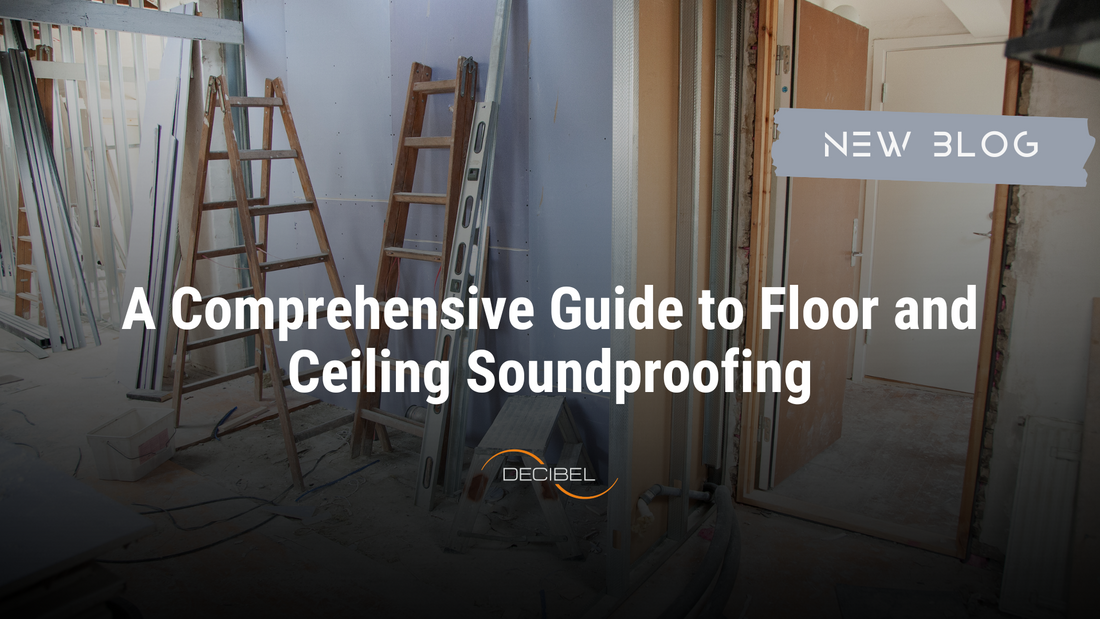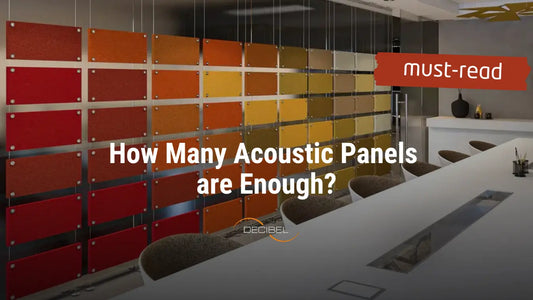
Um guia abrangente para o piso e o teto à prova de som
Tanya IlievaCompartilhar
📖 Tempo de leitura: 6 min e 27 seg
Você já notou que alguns cômodos parecem embalá-lo em silêncio, enquanto outros amplificam todos os sons, do zumbido dos eletrodomésticos ao eco de passos? Em ambientes onde o ruído prejudica o conforto e a produtividade, a compreensão como isolar eficazmente o som Pisos e tetos são vitais. Este guia examina soluções avançadas para isolamento acústico de tetos e pisos, discutindo seus méritos técnicos, etapas práticas de instalação e armadilhas comuns a serem evitadas.
Aqui estão duas lições importantes para começar:
- Para ruído de impacto, muitas vezes é mais eficaz concentrar-se no tratamento do piso acima do que insonorização do teto abaixo.
- Insonorização de pisos é mais eficaz quando planejado com antecedência e adaptado à estrutura específica do edifício.
Interessado? Vamos começar do começo.
Os desafios da insonorização de tetos e pisos
O som se propaga de forma diferente através dos diferentes elementos da construção. Tetos e pisos apresentam desafios únicos, pois transmitem tanto ruído aéreo (vozes, música) quanto ruído de impacto (passos, queda de objetos) por meio de vibrações estruturais. Pesquisas indicam que o ruído de impacto pode ser até 40% mais perturbador do que o ruído aéreo, já que suas vibrações se movem ao longo de estruturas contínuas, tornando-as mais difíceis de controlar sem sistemas especializados.

A complexidade da insonorização de tetos
Insonorização Isolar tetos é mais complexo do que isolar paredes por dois motivos principais. Em primeiro lugar, quando o ruído penetra através de um teto, é frequentemente caracterizado como ruído de impacto. O ruído de impacto, como passos ou objetos caídos, viaja pela estrutura do edifício e "se espalha" pelas paredes, pisos e vigas, causando vazamentos de som pelas divisórias adjacentes. Como já mencionado, pesquisas indicam claramente que o ruído de impacto é particularmente difícil de controlar, pois suas vibrações são transmitidas por caminhos estruturais contínuos.
Em segundo lugar, a maioria dos cômodos não tem pé-direito suficiente para instalar uma camada espessa e eficaz de isolamento acústico. Em muitos espaços residenciais, adicionar isolamento volumoso ao teto reduziria significativamente a altura do teto, comprometendo a estética, a funcionalidade e a sensação geral do cômodo. Nossa experiência mostra que o isolamento acústico ideal do teto é alcançado quando o sistema evita conexões rígidas — garantindo que todos os caminhos de vibração e transmissão sonora sejam bem interrompidos — e, às vezes, é combinado com isolamento em paredes paralelas para mitigar o vazamento de ruído residual.
Desafios e Soluções Estratégicas para Insonorização de Pisos
Embora a insonorização de pisos também seja desafiadora, geralmente é mais fácil do que a insonorização de tetos, mas mais complexa do que o tratamento de paredes. Os pisos costumam atuar como amplificadores de ruído, transmitindo tanto o ruído de impacto (de passos e móveis em movimento) quanto o ruído aéreo entre os níveis.
Aqui estão alguns conselhos profissionais para ter em mente:
- Integração de design inicial:A incorporação de isolamento acústico na fase de projeto garante que até mesmo áreas comuns, como escadas e patamares entre andares, sejam efetivamente insonorizadas.
- Soluções sob medida:A escolha dos sistemas de isolamento acústico do piso depende de vários fatores: a espessura da laje, o tipo de ruído (impacto versus aéreo), o pé-direito que você está disposto a sacrificar, o tipo de revestimento do piso e a função do cômodo.
- Considerações práticas:Se a insonorização do piso não for integrada desde o início, ela poderá ser adicionada posteriormente.No entanto, essa reforma pode alterar ligeiramente o nível do piso. É recomendável consultar especialistas para uma avaliação precisa e uma solução ideal.
O C-MUTE SYSTEM™ : Insonorização Avançada de Tetos
Existe uma solução inovadora de isolamento acústico de teto projetada para reduzir eficazmente o ruído aéreo. Utilizando fixadores antivibração patenteados,
- Opções de espessura personalizáveis: O sistema oferece painéis com espessuras de 23 mm, 33 mm e 63 mm. Cada opção oferece diferentes ganhos adicionais de isolamento: +11 dB para 23 mm, +13 dB para 33 mm e +17 dB para 63 mm.
- Métricas de desempenho: As classificações de isolamento de ruído aéreo (Rw) alcançadas são 65 dB, 67 dB e 71 dB, respectivamente, garantindo que sons perturbadores de vizinhos movimentados no andar de cima sejam significativamente reduzidos.
- Recomendação de instalação: É aconselhável finalizar a instalação com uma camada de placa de gesso de 12,5 mm ou 15 mm, o que melhora ainda mais o desempenho acústico.
Se essas métricas de desempenho não significam nada para você, não se preocupe, entre em contato conosco e explicaremos em linguagem humana para que você possa tomar uma decisão informada.
Abordagens inovadoras de isolamento acústico de pisos com F-MUTE SYSTEM™ e Dpact Membrana de isolamento acústico
Pisos, muitas vezes amplificadores involuntários de ruído, exigem soluções dedicadas para lidar com ruídos de impacto e aéreos. Duas soluções avançadas abordam esses desafios de diferentes ângulos. O
Em contraste, o

Comparando a insonorização de tetos e pisos: uma abordagem holística para o controle de ruído
Para atingir a redução máxima de ruído, uma abordagem integrada é fundamental.
Teto vs. Piso
A insonorização do teto aborda principalmente o ruído aéreo, enquanto a insonorização do piso deve abordar tanto o ruído de impacto (por exemplo, passos) quanto o ruído aéreo (por exemplo, conversas).
O
Sinergia do Sistema
A combinação desses sistemas cria uma barreira acústica abrangente em edifícios de vários andares. Por exemplo, isolar o teto e o piso de um apartamento pode reduzir a transmissão geral de ruído em mais de 50%, de acordo com estudos recentes do setor.
Impacto no mundo real
Quando ambos os sistemas são usados juntos, eles garantem que, mesmo que um nível produza ruído, o espaço vizinho permaneça sereno - o que significa maior qualidade de vida e aumento de produtividade.

Erros comuns na insonorização de pisos e tetos
Muitos proprietários e profissionais cometem erros previsíveis ao tentar realizar a insonorização. Aqui estão algumas das armadilhas mais frequentes e como evitá-las:
Avaliação inadequada de fontes de ruído
Não identificar se o problema principal é o ruído aéreo ou o ruído de impacto pode levar à aplicação da solução errada. Pesquisas sugerem que uma análise detalhada do ruído pode melhorar a eficácia do isolamento acústico em até 30%.
Negligenciando lacunas e costuras
Mesmo pequenos vãos ao redor de luminárias ou entre painéis podem permitir vazamentos significativos de ruído. Usar selantes acústicos ao redor de janelas, portas e bordas de painéis é essencial para evitar que esses pontos fracos prejudiquem seus esforços de isolamento acústico.
Com vista para o desacoplamento estrutural
Muitos projetos "faça você mesmo" pulam a etapa de desacoplamento de superfícies, essencial para reduzir as vibrações que se propagam por estruturas contínuas. Técnicas como canais resilientes e fixadores antivibração comprovadamente reduzem drasticamente a transmissão de ruído.
Seleção inadequada de materiais
Confiar em materiais inadequados ou apenas em um tipo de material, como espuma acústica, sem considerar a necessidade de barreiras densas, pode resultar em um controle de ruído abaixo do ideal. Uma abordagem equilibrada, utilizando materiais absorventes e bloqueadores, garante uma solução abrangente.
Instalação inadequada
Mesmo os melhores produtos podem falhar se não forem instalados corretamente. Painéis mal montados ou adesivos aplicados incorretamente podem criar vãos que comprometem o desempenho geral. Garantir que as diretrizes de instalação sejam seguidas é fundamental para o sucesso.
Ignorando a integração de soluções de piso e teto
Muitas vezes, as pessoas se concentram em apenas um aspecto do isolamento acústico (por exemplo, painéis de teto) e negligenciam o piso, ou vice-versa. Uma estratégia holística que considere todas as superfícies por onde o som se propaga é necessária para alcançar os melhores resultados.
Comprometendo a estética pela função
Algumas instalações priorizam excessivamente a funcionalidade, resultando em soluções volumosas e pouco atraentes que impactam o design e o espaço do ambiente. As soluções ultrafinas modernas C-MUTE e F-MUTE SYSTEM foram projetadas para oferecer desempenho e aparência elegante, sacrificando o mínimo de espaço possível.

Considerações práticas sobre instalação
Uma insonorização eficaz requer não apenas os produtos certos, mas também planejamento e instalação adequados.
- Avaliação: Comece com uma avaliação completa do seu espaço, determinando as principais fontes de ruído e medindo as áreas de cobertura.
- Instalação: Para pisos e tetos, certifique-se de que a superfície esteja limpa antes de instalar os painéis. Não se esqueça de aplicar uma camada de gesso cartonado sobre os painéis sempre que possível.
- Consulta Profissional: Instalações complexas (especialmente em edifícios de vários andares) se beneficiam de consultoria especializada para alcançar resultados ideais sem sacrificar o pé-direito ou a estética do design.
- Integração: Combinar isolamento acústico de teto e piso com medidas complementares, como painéis acústicos em paredes e estofados, pode criar um ambiente unificado e mais silencioso.
A jornada para uma casa mais silenciosa começa com a compreensão da complexa ciência da transmissão sonora e dos desafios reais da construção. A insonorização eficaz é tanto uma arte quanto uma ciência. Como adoramos dizer: "Parece mágica, mas é ciência."
Ao entender como o som se propaga através de tetos e pisos, evitar erros comuns, usar a combinação certa de materiais e fazer a instalação correta, você pode superar facilmente até os problemas de ruído mais complexos. Adotar uma abordagem integrada garante que cada parte do seu edifício contribua para um ambiente de vida ou trabalho mais silencioso e confortável. Para sempre!
Recursos de leitura adicionais
-
Everest, FA, & Pohlmann, KC (2015). Manual Mestre de Acústica (6ª ed.). Nova Iorque: McGraw-Hill Education.
-
Long, M. (2014). Acústica Arquitetônica (2ª ed.). Elsevier Academic Press.
-
Beranek, LL, & Vér, IL (2006). Engenharia de Controle de Ruído e Vibração: Princípios e Aplicações. John Wiley & Sons.
-
Cox, TJ, & D'Antonio, P. (2017). Absorventes e Difusores Acústicos: Teoria, Projeto e Aplicação (3ª ed.). CRC Press.
-
Organização Mundial da Saúde. (2018). Diretrizes sobre Ruído Ambiental para a Região Europeia. Escritório Regional da OMS para a Europa, 2018.
-
"A eficácia das soluções de isolamento acústico em edifícios de vários andares", Journal of Building Acoustics, 2020, DOI: 10.1177/0143624419897582.
-
"Redução de ruído de impacto em pisos residenciais: um estudo comparativo", Building Research & Information, 2019, DOI: 10.1080/09613218.2019.1585314.




